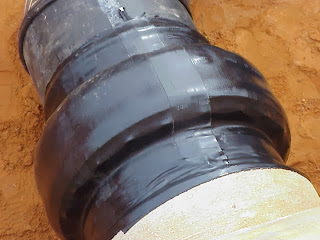Chinese Shrink Sleeves in the USA?
I've recently heard a report from a customer stating that a Chinese shrink sleeve manufacturer has infiltrated the USA with some counterfeit WCSM shrink sleeves. The word is that these sleeves are marked "Raychem Tyco Electronics WCSM" - is true illegal copies. Of course, the difference in the products was noticed immediately - and confirmed during the shrink process. The Chinese cannot replicate the quality of a Raychem shrink sleeve (or a Covalence shrink sleeve). But still, this is QUITE disturbing!
I've heard stories for years of counterfeit products of all kinds. In fact, I may (or may not) even have friends who've purchased counterfeit watches from various spots around the world. I've also heard reports of Chinese manufacturers counterfeiting different cold applied tapes and selling them into South America and Middle East to the tune of millions of dollars, but this is the first I've heard of these fake pipeline coatings being sold in the United States of America. What is our world coming to??
This is a disturbing development. Here is what happens: A customer has been buying REAL Raychem WCSM from us...say they are paying around $22.50 for a four foot stick of WCSM 34/8-1200-S. It works great. It has worked great for the last 10 years. It always works great. It always installs the same. Suddenly they have an email or a salesperson in their office saying "I can sell you our (fake) WCSM 34/8-1200-S for 12$ per stick." The customer buys it. The customer sees a difference in the tubing - it feels thinner; flimsier - like maybe it is a low density polyethylene. It also smells funny and the adhesive looks and feels different. Oh well, let's install it anyway.
During the installation, the fake tube shrinks more slowly and kind of irregularly. The fake tubing also gets a shiny surface to it during the install process. They also notice that the adhesive doesn't flow the same and there is smoke coming from the shrink sleeve, which is unusual. Beyond all of that, the PE doesn't look as thick as it normally does - but it DOES say "Raychem" on it....
A few months (or weeks) down the road, they notice their electrical connections begin failing. The heat shrink that they used to seal them up aren't actually sealing anything! This is a BIG problem. The few dollars saved by purchasing a cheap fake (in their defense - they didn't know they were purchasing a fake product) has actually turned out to be a multi-thousand dollar mistake. OUCH. Not worth it!!
For all Raychem / Tyco Electronics / Covalence products that we sell - we are able to supply a Certificate of Conformance upon request. Everything we purchase is purchased directly from the factory. You can buy from us with confidence.
Fortunately, I haven't heard of any Covalence products being counterfeited right here in the USA. I sure hope that holds true in the future!




